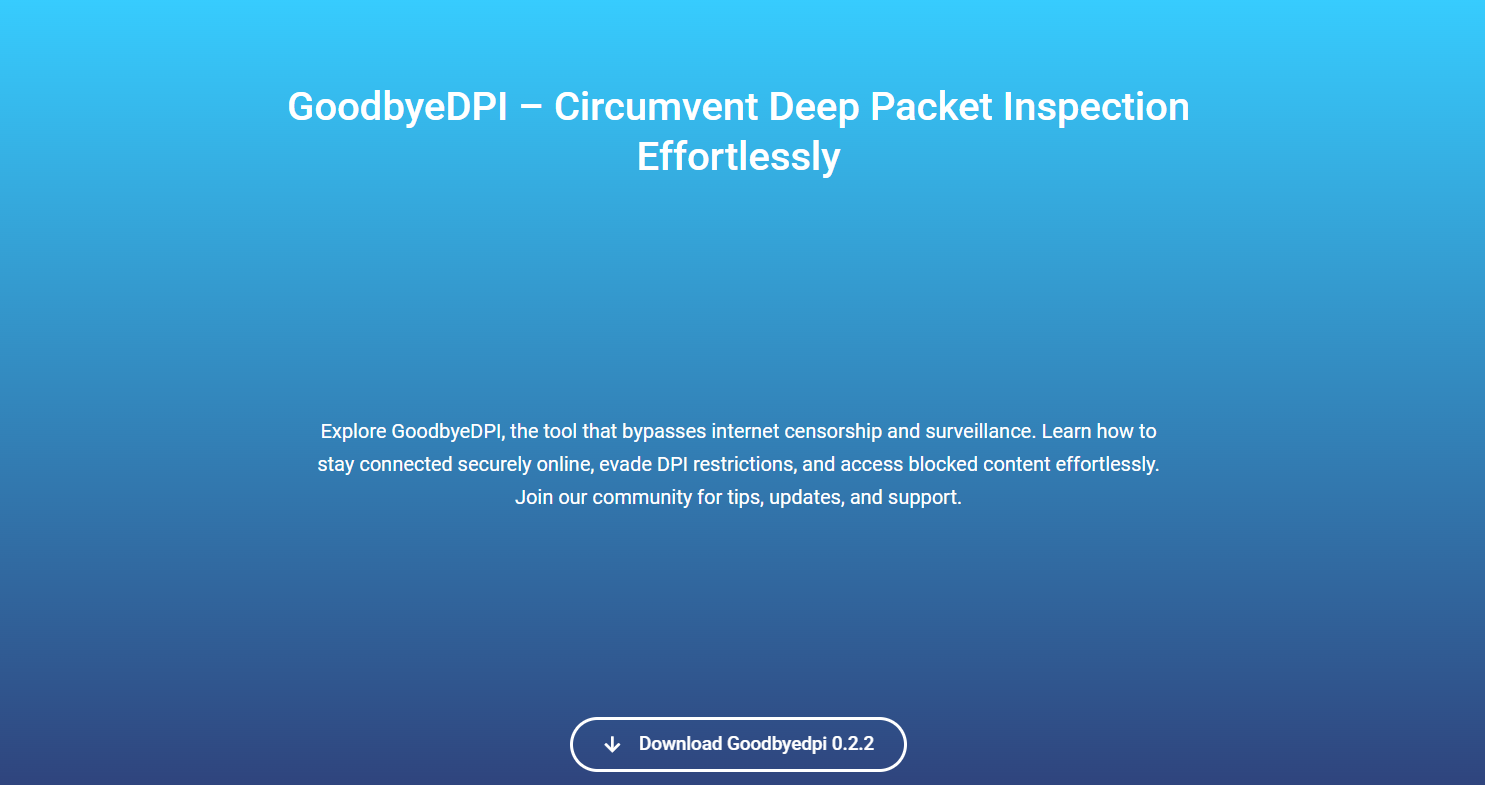Governments worldwide increasingly deploy Deep Packet Inspection (DPI) to restrict access to certain websites, censor digital content, and monitor user behavior. In response, tools have emerged to counter this wave of control. Among them, GoodbyeDPI stands out for its simplicity, efficiency, and open-source approach. But does it truly stand as the best solution for preserving internet freedom?
Let’s unpack GoodbyeDPI’s features, limitations, and real-world applications to see where it fits in the modern digital rights landscape.
Understanding Deep Packet Inspection and Its Impact
Deep Packet Inspection is an advanced form of data filtering used by ISPs and governments. Unlike basic traffic monitoring that looks only at headers, DPI inspects the actual content of data packets traveling across the internet.
This level of inspection allows network authorities to:
- Block access to specific websites
- Throttle services like streaming or torrents
- Monitor user behavior for surveillance
- Redirect users to fake or censored pages
The rise of DPI technology has escalated the battle for online freedom. Regular users in censored regions are increasingly cut off from global conversations, educational resources, and unrestricted information. For those users, tools like GoodbyeDPI become not just utilities, but lifelines.
How GoodbyeDPI Works in Practice
GoodbyeDPI is a lightweight Windows-based utility designed to neutralize DPI-based censorship by subtly altering outbound internet traffic. The software doesn’t rely on proxies, VPNs, or encrypted tunnels. Instead, it focuses on evading detection by modifying how packet headers and requests are structured.
Key techniques used by GoodbyeDPI include:
- Fragmenting HTTP requests: Splits headers into multiple packets to confuse DPI filters.
- Removing or altering Host headers: Prevents DPI systems from recognizing blacklisted domains.
- Injecting junk headers: Adds noise to requests, throwing off signature-based filters.
- Disabling SNI (Server Name Indication): Avoids exposure of domain names during SSL handshakes.
These tactics work without creating new connections or relying on third-party servers, which makes the tool extremely fast and minimally invasive.
Advantages of GoodbyeDPI for Everyday Users
The real power of GoodbyeDPI lies in its combination of speed, stealth, and simplicity. Compared to VPNs and Tor, it offers a different set of strengths that appeal to users in highly censored or monitored regions.
Lightweight and Resource-Efficient
No heavy encryption layers or routing across distant servers means you can use GoodbyeDPI on even low-end hardware without lag or battery drain.
No Need for Third-Party Servers
Because the software operates on a packet modification level rather than routing traffic through remote servers, it avoids the pitfalls of slow or blocked VPN endpoints.
Open Source and Transparent
Being open source gives users full visibility into what GoodbyeDPI is doing. Unlike commercial VPNs that may log user data, GoodbyeDPI puts control directly in your hands.
Compatible With Most Browsers and Apps
Once installed and configured, it works in the background. You don’t need to launch specific apps or tweak browser settings.
Real-World Use Cases Where GoodbyeDPI Excels
In practice, GoodbyeDPI has been a game-changer in regions like Russia, Iran, and China, where DPI techniques are aggressively used.
Circumventing Government Firewalls
By disrupting the mechanisms of DPI detection, users can regain access to social media platforms, independent news outlets, and blocked communication tools.
Boosting Online Anonymity
While not a full anonymity tool, GoodbyeDPI plays a significant role in evading censorship fingerprints, which are often used to track users’ online activities.
Enhancing Streaming and Gaming
Some ISPs throttle traffic to video streaming or online gaming services. GoodbyeDPI can help bypass those filters without the latency often introduced by VPNs.
Comparing GoodbyeDPI with VPNs and Tor
Choosing the right tool depends on your needs. Here’s a side-by-side comparison:
| Feature | GoodbyeDPI | VPNs | Tor |
| Speed | Very Fast | Slower (depends on server) | Slow (onion routing) |
| Encryption | None (optional with HTTPS) | Strong encryption | Multi-layer encryption |
| Anonymity | Low | Medium to High | High |
| Ease of Use | Moderate (requires setup) | Easy (apps available) | Complex for beginners |
| Cost | Free | Usually Paid | Free |
| Target Audience | Censorship evasion | Privacy and security | Anonymity and whistleblowing |
GoodbyeDPI doesn’t aim to compete with VPNs or Tor on anonymity. It’s optimized for speed and accessibility in places where deep packet filtering is the main obstacle.
Downsides and Limitations
No tool is perfect, and GoodbyeDPI has its share of limitations.
Windows Only
The utility is designed for Windows systems, leaving macOS and Linux users without direct support.
No Built-in Encryption
Since it operates on packet modification, not tunneling, it doesn’t protect against surveillance that relies on monitoring content (unless used in conjunction with HTTPS).
Requires Technical Setup
While not difficult, GoodbyeDPI is not as plug-and-play as a VPN. Users may need to edit batch files, tweak firewall rules, or run command-line operations.
Efficacy Depends on DPI Methods
If an ISP uses highly adaptive or AI-based DPI systems, GoodbyeDPI may be bypassed. In such cases, more advanced or hybrid tools might be necessary.
Enhancing GoodbyeDPI With Other Tools
Many users combine GoodbyeDPI with other privacy tools to create a more robust digital defense system.
- HTTPS Everywhere: Ensures connections are always encrypted when possible.
- DNSCrypt: Secures DNS queries against tampering.
- Firewall Rules: Blocks IP ranges associated with government-controlled monitoring nodes.
- Custom Scripts: Automate GoodbyeDPI startup with VPN clients for hybrid protection.
By layering tools, users get the best of both worlds—speed and privacy.
Community Support and Development
Despite being a niche tool, GoodbyeDPI has a passionate user base, especially in countries where internet freedom is under attack. The project is actively maintained on GitHub, with updates and forks adding enhancements for new DPI methods.
This community-driven approach ensures the tool evolves in real time with the censorship tactics it aims to defeat.
Ideal Users Who Benefit the Most
GoodbyeDPI is particularly suited for:
- Students and researchers needing access to global academic content
- Journalists seeking information from censored websites
- Activists communicating via restricted platforms
- Every day, users who want a faster alternative to VPNs for bypassing restrictions
For users in regions with moderate censorship that relies heavily on DPI rather than IP blacklisting, GoodbyeDPI can be a powerful and elegant solution.
Conclusion
Internet freedom is not a one-size-fits-all challenge. The best solution depends on the level of censorship, the sophistication of DPI techniques, and the user’s need for anonymity versus speed.
GoodbyeDPI fills a critical gap—it’s not a VPN, it’s not Tor, and it doesn’t try to be. Instead, it focuses on one thing: defeating DPI-based censorship quickly and effectively, for users in tightly controlled internet environments, that can make all the difference between isolation and connection.









